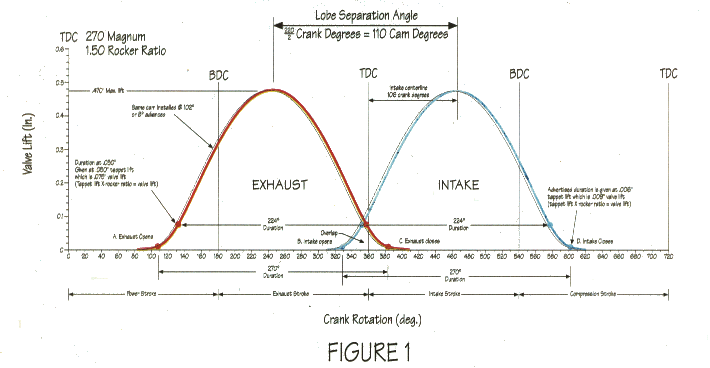Most cams are rated by duration at some defined lift
point. As slow as the valve opens and closes at the very beginning and end of its cycle,
it would be impossible to find exactly where it begins to move. In the case illustrated,
the rated duration is at .006" tappet lift. In our plot, we use valve lift so we must
multiply by the rocker arm ratio to find this lift. For example, .006" x 1.5
=.009". Instead of the original .006" tappet lift, we now use .009" valve
lift. These opening and closing points are circled so that you can see them. If you count
the number of degrees between these points you will arrive at the advertised duration, in
this case 270 degrees of crank- shaft rotation. In this illustration this is the same for
both the intake and the exhaust lobes, thus making this a single pattern cam. Some cam
manufacturers rate their cams at .050" lift. If we again multiply this by the rocker
arm ratio, we get .075". we can mark the diagram and read the duration at .050"
lift. This cam shows around 224 degrees, standard for this 270H cam. The lift is very
simple to determine. You can simply read it from the axis going up. This is the lift at
the valve as we said earlier. Sometimes you will hear lift referred to as "lobe
lift". This means the lift at the lobe or the valve lift divided by the rocker arm
ratio. In this case, it would be .470" divided by 1.5 or .313" lobe lift. The
lift is simply a straightforward measurement of the rise of the valve or lifter. 
We touched on opening and closing points a little earlier, but now
we want to consider them even further. We talked about when these points occur, and how
they are measured. As you can see in figure 1, the valve begins to move very slowly then
picks up speed as it approaches the top. It does the same closing, coming down quickly
then slowing to a gentle stop. It's kind of like driving your car. If you were to go from
0 to 60 mph in a fraction of a second and stop instantly, you can imagine what that would
do to the car, not to mention the driver. It would be much too severe for any valve train
to endure. You would bend pushrods, wear out cams, break springs and rockers, and lose all
dynamic design. The cam would not run to the desired RPM level as you would have all these
parts running into each other. As the valve approaches the seat, you also have to slow it
down to keep the valve train from making any loud noises. If you slam the valve down onto
the seat, you can expect some severe noise and a lot of worn and broken parts. So it is
easy to see that you can only accelerate the valve a certain amount before you get into
trouble. This is some- thing Competition Cams has learned over the years-how far you can
safely push this point.
Looking a bit further at the timing points, the first one we see on
the diagram is the exhaust opening point. We have all noticed the different sounds of
performance cams, with the distinct lopes or rough idle. This occurs when the exhaust
valve opens earlier and lets the sound of combustion go out into the exhaust pipes. It may
actually still be burning a little when it passes out of the engine, so this can be a very
pronounced sound.
The next point on the graph is the intake opening. This begins the
overlap phase, which is very critical to vacuum, throttle response, emissions and
especially, gas mileage. The amount of overlap, or the area between the intake opening and
the exhaust closing, and where it occurs, is one of the most critical points in the engine
cycle. If the intake valve opens too early, it will push the new charge into the intake
manifold. If it occurs too late, it will lean out the cylinder and greatly hinder the
performance of the engine. If the exhaust valve closes too early it will trap some of the
spent gases in the combustion chamber, and if it closes too late it will over-scavenge the
chamber; taking out too much of the charge, again creating an artificially lean condition.
If the overlap phase occurs too early, it will create an overly rich condition in the
exhaust port, severely hurting the gas mileage. So, as you can see, everything about
overlap is critical to the performance of the engine.


You can reach the author by e-mail at: compcams@memphisonline.com